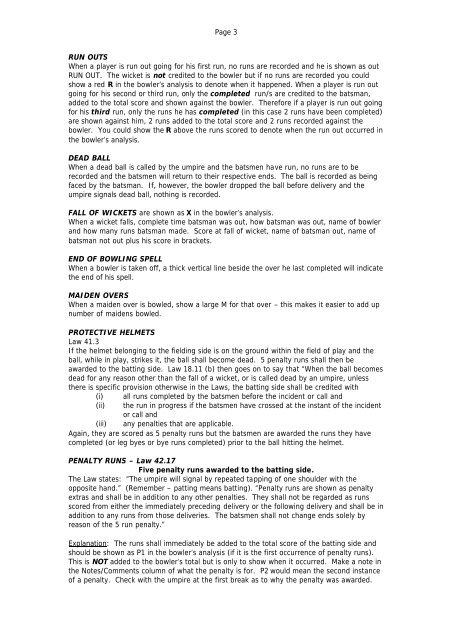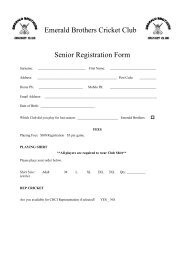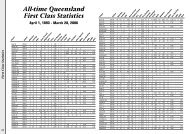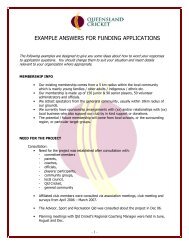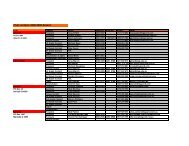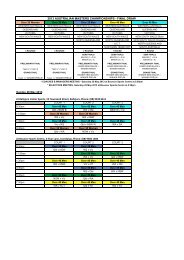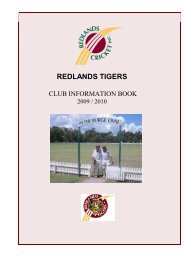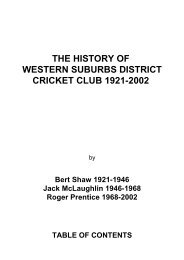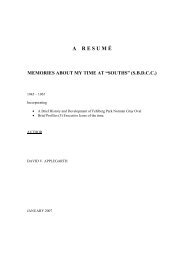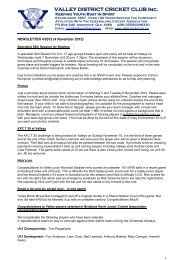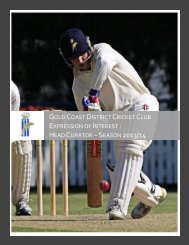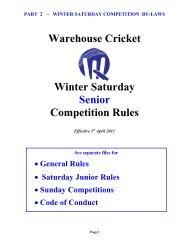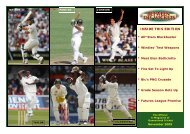Queensland Cricket Scoring Manual - Latrobe Cricket Club
Queensland Cricket Scoring Manual - Latrobe Cricket Club
Queensland Cricket Scoring Manual - Latrobe Cricket Club
Create successful ePaper yourself
Turn your PDF publications into a flip-book with our unique Google optimized e-Paper software.
Page 3<br />
RUN OUTS<br />
When a player is run out going for his first run, no runs are recorded and he is shown as out<br />
RUN OUT. The wicket is not credited to the bowler but if no runs are recorded you could<br />
show a red R in the bowler’s analysis to denote when it happened. When a player is run out<br />
going for his second or third run, only the completed run/s are credited to the batsman,<br />
added to the total score and shown against the bowler. Therefore if a player is run out going<br />
for his third run, only the runs he has completed (in this case 2 runs have been completed)<br />
are shown against him, 2 runs added to the total score and 2 runs recorded against the<br />
bowler. You could show the R above the runs scored to denote when the run out occurred in<br />
the bowler’s analysis.<br />
DEAD BALL<br />
When a dead ball is called by the umpire and the batsmen have run, no runs are to be<br />
recorded and the batsmen will return to their respective ends. The ball is recorded as being<br />
faced by the batsman. If, however, the bowler dropped the ball before delivery and the<br />
umpire signals dead ball, nothing is recorded.<br />
FALL OF WICKETS are shown as X in the bowler’s analysis.<br />
When a wicket falls, complete time batsman was out, how batsman was out, name of bowler<br />
and how many runs batsman made. Score at fall of wicket, name of batsman out, name of<br />
batsman not out plus his score in brackets.<br />
END OF BOWLING SPELL<br />
When a bowler is taken off, a thick vertical line beside the over he last completed will indicate<br />
the end of his spell.<br />
MAIDEN OVERS<br />
When a maiden over is bowled, show a large M for that over – this makes it easier to add up<br />
number of maidens bowled.<br />
PROTECTIVE HELMETS<br />
Law 41.3<br />
If the helmet belonging to the fielding side is on the ground within the field of play and the<br />
ball, while in play, strikes it, the ball shall become dead. 5 penalty runs shall then be<br />
awarded to the batting side. Law 18.11 (b) then goes on to say that “When the ball becomes<br />
dead for any reason other than the fall of a wicket, or is called dead by an umpire, unless<br />
there is specific provision otherwise in the Laws, the batting side shall be credited with<br />
(i) all runs completed by the batsmen before the incident or call and<br />
(ii) the run in progress if the batsmen have crossed at the instant of the incident<br />
or call and<br />
(iii) any penalties that are applicable.<br />
Again, they are scored as 5 penalty runs but the batsmen are awarded the runs they have<br />
completed (or leg byes or bye runs completed) prior to the ball hitting the helmet.<br />
PENALTY RUNS – Law 42.17<br />
Five penalty runs awarded to the batting side.<br />
The Law states: “The umpire will signal by repeated tapping of one shoulder with the<br />
opposite hand.” (Remember – patting means batting). “Penalty runs are shown as penalty<br />
extras and shall be in addition to any other penalties. They shall not be regarded as runs<br />
scored from either the immediately preceding delivery or the following delivery and shall be in<br />
addition to any runs from those deliveries. The batsmen shall not change ends solely by<br />
reason of the 5 run penalty.”<br />
Explanation: The runs shall immediately be added to the total score of the batting side and<br />
should be shown as P1 in the bowler’s analysis (if it is the first occurrence of penalty runs).<br />
This is NOT added to the bowler’s total but is only to show when it occurred. Make a note in<br />
the Notes/Comments column of what the penalty is for. P2 would mean the second instance<br />
of a penalty. Check with the umpire at the first break as to why the penalty was awarded.


